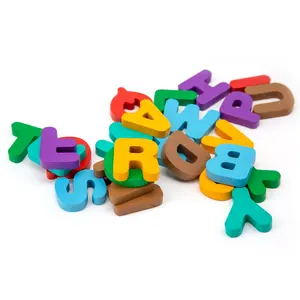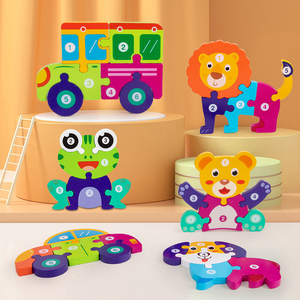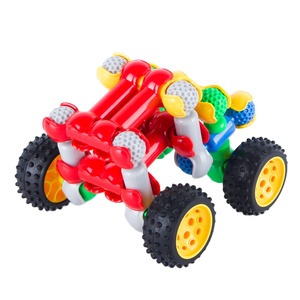(78895 products available)















































































































































































While choosing toys for 2-year-olds, consider their interests and abilities. Choose toys that will help them learn and have fun. The most common types of these toys include;
Building toys
For toddlers, building toys are used to make structures and shapes. These toys assist in the development of motor and cognitive skills. They also encourage creativity in children. Examples of building toys are Mega Bloks and large Lego Duplo blocks.
Shape and color sorters
These toys have different shapes and colors. They come in boxes or puzzles with holes that match the shapes. They assist in the identification of colors and shapes. They also improve hand-eye coordination. They do this by having children fit the shapes into the appropriate openings. Shape sorters and stacking rings are examples of shape and color sorters.
Musical instruments
Simple musical instruments are for toddlers to make sounds easily. These toys encourage a love of music from a young age. They also assist in the development of fine motor abilities. They do this by allowing children to bang on drums and shake maracas. Other examples are xylophones and small keyboards.
Push and pull toys
These are toys that have wheels and handles for pulling or pushing. They have an encouraging effect on toddlers who are learning to walk. These toys improve coordination and balance as well as gross motor abilities. These toys include wagons, dogs, and wooden trains with pull handles.
Imaginative play toys
Toys that encourage creative play often come in the form of simple household items. For instance, food and utensils found in kitchens. When children pretend to cook and serve food, these toys assist in the development of social abilities. They also enhance language skills. This is because they encourage storytelling and conversation. Small kitchens, food sets, and pots and pans are examples of imaginative play toys.
Interactive toys
These toys respond to a child's actions, such as pressing a button or pulling a lever. They often play sounds, lights, or moving parts. They assist in the teaching of cause-and-effect relationships. They also provide sensory stimulation to children. These toys include talking books, activity centers, and electronic animal pets.
Soft toys and dolls
Stuffed animals and dolls are comforting companions for toddlers. This is because they are soft. These toys are usually comforting. They teach toddlers how to care for others. This is done by imitating behaviors. For example, feeding and rocking. These toys include teddy bears, dolls, and animals.
When buying toys for 2-year-olds, consider their interests and what will help them grow. At this age, children like to play with things that move, make noise, or can be put together in different ways. These toys also help them learn new skills and make sense of the world around them. For instance, a toy train can be fun for a child who likes watching trains go by, while building blocks allow them to create structures like houses or towers they see in real life.
Toys for 2-year-olds should be strong enough to last through rough play since toddlers are still learning how to handle things gently. They should also be made from safe materials because little kids often put objects in their mouths. Furthermore, such toys should be the right size so that they do not get stuck in a child's throat and cause choking hazards. More importantly, the toys should be age-appropriate to ensure that the child does not get overwhelmed by complex parts or too many buttons to press.
Two-year-olds enjoy playing with their parents or caregivers, so buying toys to encourage this interaction is helpful. For example, a ball can be rolled back and forth between them, while a puzzle may require both parties to think together. Such toys promote bonding and help children learn through shared experiences. Moreover, just like any other item, toys for 2-year-olds should be regularly checked for damages. If one looks broken or worn out, it is best to dispose of it, as such pieces may still injure the child even if they do not work anymore.
Finally, think about how much space is available in the house before buying big sets of toys. Some playthings come with several parts that need more room than others. Therefore, ensure there is enough area both inside the box and around it, where kids can move freely while playing with them. In summary, choose wisely when getting playthings meant for toddlers; doing so will create safe environments filled with enjoyable experiences.
To make the most out of playtime, it is important to choose the right toys for 2-year-olds. Knowing the functions, features, and designs of these toys helps one understand why they are great for little ones. This knowledge allows parents and caregivers to select toys that will make playtime enjoyable and beneficial for 2-year-olds.
For kids who are 2 years old, the main thing that toys do is to make them have fun and learn new things. These toys help the kids' imagination grow and let them explore different textures and shapes. This exploration helps the kids develop their senses and creativity. Moreover, toys for 2-year-olds keep them entertained and help them learn about cause and effect. For example, if a child presses a button on a toy and it makes a sound, the child learns that pressing the button brings about the sound. This understanding helps the child become more curious about the world around them.
Toys for 2-year-olds usually have bright colors that catch the child's eye and interesting textures that make the toy fun to touch. Many of these toys also make sounds, like music or animal noises, which help the child learn to talk and sing along. Some toys can be pushed or pulled, helping the child move and be active. These toys are also made to be safe for 2-year-olds so they won't break easily, and they won't have small pieces that could make the child choke.
To ensure that 2-year-olds can play with the toys easily, they are designed to be held by tiny hands. The toys are also made to be interesting for the children, with many having moving parts or making sounds when pressed. The materials used to make these toys are soft and easy for the child to grab. The designs of these toys make them safe for 2-year-olds to play with, even if they put them in their mouths. The shapes are round, and there are no sharp edges that could cut the child. The toy's colors are bright, making them look fun from a distance. Also, the toy's designs are simple, making it easy for the child to understand how to play with them.
When choosing toys for 2-year-olds, safety is the most crucial thing to remember. Here are some essential safety features and considerations:
Age Appropriateness
Manufacturers label this with the appropriate age range. They design these toys to suit the developmental stages and abilities of children at that age.
Non-Toxic Materials
The materials that make up the toys should be BPA-free plastics, lead-free paints, and non-toxic fabrics. Parents should ensure the materials meet the safety standards.
Choking Hazard Prevention
Toys should not have small parts that can cause choking hazards. This includes parts that can detach and be less than 1.25 inches (3 centimeters) in diameter.
Durability
Manufacturers should make the toys from sturdy materials, able to endure rough play without breaking or splintering.
Soft Edges
The toy's edges and corners should be round and smooth to minimize cuts and scrapes.
Electrical Safety
The electrical components of the toys should have secure battery compartments that are out of reach of the child. Parents should avoid toys with loose wires or easily accessible batteries.
When evaluating toys for 2-year-olds, several quality features make some toys stand out. Here are some critical quality features to consider:
Educational Value
These toys promote the development of both fine and gross motor skills, encourage creativity, and stimulate cognitive development. Toys that foster problem-solving skills, such as puzzles and building sets, are also ideal.
Interactivity
Toys that are interactive provide a more engaging experience. These toys respond to a child's actions with lights, sounds, or movement. This encourages active participation in play. In addition, interactive toys promote social skills and communication when they are playing with other children or adults.
Versatility
These toys are multipurpose and can be used in various ways. This allows them to adapt as the child grows. Such toys offer extended play value and are more cost-effective.
Ease of Cleaning
It is necessary to consider the ease of cleaning when it comes to hygiene. Toys with washable fabrics or surfaces are preferable. This is because they are easy to maintain.
What does it mean when a toy is developmentally appropriate?
Toys that are developmentally suitable for a two-year-old are those that support the child's growth in various areas while also being safe and fun for them to use. Such toys, for instance, may assist a child in learning how to speak by enabling them to interact with them or in developing their muscles by being able to handle them easily.
Is it necessary for the toys of two-year-olds to be educational?
While not all toys need to be educational, they should be able to promote a certain level of learning. For instance, toys that teach numbers, letters, shapes, or colors may be helpful, but there should also be play wherein a child can learn things through imagination and creativity.
How can one determine if a toy is safe for a two-year-old?
To determine whether a toy is safe for a child, one should look for the label "Ages 2 and Up" from the Consumer Product Safety Commission (CPSC). This label indicates that the toy has been tested and found safe for children above two years of age. Also, one should avoid toys with small parts, sharp edges, or toxic substances.
How does one clean and maintain toys for two-year-olds?
One should clean the toys regularly using a damp cloth with soap and water or disinfectant wipes. Also, toys that are used for feeding a child and those that are frequently touched by a child should be cleaned more often.